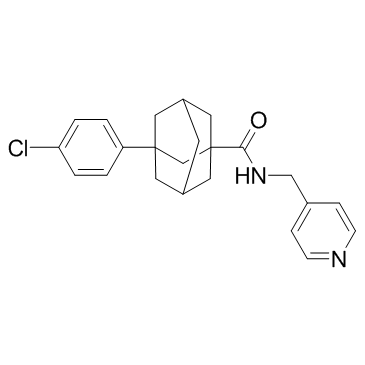915385-81-8
| Name | Tricyclo[3.3.1.13,7]decane-1-carboxamide, 3-(4-chlorophenyl)-N-(4-pyridinylmethyl) |
|---|---|
| Synonyms |
Tricyclo[3.3.1.1]decane-1-carboxamide, 3-(4-chlorophenyl)-N-(4-pyridinylmethyl)-
3-(4-Chlorophenyl)-N-(4-pyridinylmethyl)-1-adamantanecarboxamide ABC 294640 3-(4-chloro-phenyl)-adamantane-1-carboxylic acid (pyridin-4-ylmethyl)-amide ABC294640 |
| Description | Opaganib (ABC294640) is a selective, competitive sphingosine kinase 2 (SK2) inhibitor with Ki of 9.8 μM. |
|---|---|
| Related Catalog | |
| Target |
Ki: 9.8 μM (SK2)[1] |
| In Vitro | Using recombinant human SK1 and SK2, Opaganib demonstrates dose-dependent inhibition of SK2 with an IC50 of approximately 60 μM without affecting the activity of SK1 at concentrations up to at least 100 μM. In contrast, N,N-dimethylsphingosine (DMS) inhibits both SK1 and SK2 with IC50 values of approximately 60 and 20 μM, respectively. Kinetic analyses of varying concentrations of Opaganib (ABC294640) in the presence of 2.5 to 25 μM sphingosine indicated a Ki of 9.8±1.4 μM for the inhibition of SK2. Opaganib (ABC294640) decreases [3H]S1P formation in a dose-dependent fashion with an IC50 value of 26 μM[1]. IC50 values for Opaganib (ABC294640) are approximately 50 and 60 μM for A-498 and Bxpc-3 cells, respectively; whereas the IC50 values for Opaganib (ABC294640) are approximately 20 and 40 μM for these cells[2]. |
| In Vivo | Opaganib induces a transient minor decrease in the hematocrit of rats. Hematology studies indicate decreases in red blood cell number and hematocrit of approximately 20% in animals given either 100 or 250 mg/kg/day; and a slight increase in neutrophils and decrease in basophils in the treated rats[1]. Mice are gavaged with Opaganib (50 mg/kg), a selective inhibitor of sphingosine kinase-2 (SK2), 1 h before surgery and subjected to 1 h-warm ischemia to ~70% of the liver followed by reperfusion. Opaganib-treatment largely prevented the increase of sphingosine-1-phosphate (S1P) after ischemia-reperfusion (IR) in vivo[2]. |
| Cell Assay | To determine the effects of the test compounds (e.g., Opaganib (ABC294640)) on proliferation, cells are plated into 96-well microtiter plates and allowed to attach for 24 h. Varying concentrations of Opaganib are added to individual wells and the cells are incubated for an additional 72 h. At the end of this period, the number of viable cells is determined by use of the sulforhodamine-binding assay. The percentage of cells killed is calculated as the percentage decrease in sulforhodamine-binding compare with control cultures. Regression analyses of inhibition curves are performed by use of GraphPad Prism[1]. |
| Animal Admin | Rats[1] Sprague-Dawley male rats (7-8 weeks old) are orally dosed with 0, 100, or 250 mg of ABC294640•HCl/kg in 0.375% Polysorbate-80 in PBS daily for 7 days. The animals are observed daily for viability, signs of gross toxicity, and behavioral changes, and a battery of detailed observations are performed on study days 1 and 7. Blood is sampled from all animals on day 8 of the study for hematology, clinical biochemistry, and serology assessments, and the animals are sacrificed. Gross necropsies are performed on all study rats, and selected organs and tissues are evaluated in the control and high-dose level groups. Mice[3] Male C57BL/6 (8-9 weeks) mice are gavaged with 50 mg/kg of Opaganib (ABC294640), or an equivalent volume of vehicle (0.375% Tween 80 in phosphate buffered saline, pH 7.1) 1 h before surgery. Under ether anesthesia, ischemia to 70% of the total liver is induced for 1 h. After opening the vascular clamp, the non-ischemic liver lobes are removed, and mice are observed 7 days for survival. Sham operation included equivalent anesthesia and laparotomy without ischemia. |
| References |
| Density | 1.3±0.1 g/cm3 |
|---|---|
| Boiling Point | 589.5±50.0 °C at 760 mmHg |
| Molecular Formula | C23H25ClN2O |
| Molecular Weight | 380.910 |
| Flash Point | 310.3±30.1 °C |
| Exact Mass | 380.165527 |
| PSA | 41.99000 |
| LogP | 4.16 |
| Vapour Pressure | 0.0±1.7 mmHg at 25°C |
| Index of Refraction | 1.632 |
| Storage condition | 2-8°C |
